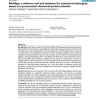BMCBI
2011
13 years 10 months ago
2011
Background: The increasing availability of molecular sequence data means that the accuracy of future phylogenetic studies is likely to by limited by systematic bias and taxon choi...
DAM
2000
14 years 3 months ago
2000
Abstract. The amalgamation of leaf-labelled (phylogenetic) trees on overlapping leaf sets into one (super)tree is a central problem in several areas of classification, particularly...
JCB
2006
14 years 3 months ago
2006
We describe a novel method for efficient reconstruction of phylogenetic trees, based on sequences of whole genomes or proteomes, whose lengths may greatly vary. The core of our me...
JBI
2006
14 years 3 months ago
2006
Systematic analyses are included as integral parts of bioinformatic analysis. The use of phenetic and phylogenetic trees in many of the newer areas of biology create a need for bi...
BMCBI
2007
14 years 3 months ago
2007
Background: Automated methods for assembling families of orthologous genes include those based on sequence similarity scores and those based on phylogenetic approaches. The first ...
BMCBI
2006
14 years 3 months ago
2006
Background: Phylogenetic analysis of large, multiple-gene datasets, assembled from public sequence databases, is rapidly becoming a popular way to approach difficult phylogenetic ...
BMCBI
2006
14 years 3 months ago
2006
Background: Phylogenetic methods which do not rely on multiple sequence alignments are important tools in inferring trees directly from completely sequenced genomes. Here, we exte...
BMCBI
2006
14 years 3 months ago
2006
Background: Until today, analysis of 16S ribosomal RNA (rRNA) sequences has been the de-facto gold standard for the assessment of phylogenetic relationships among prokaryotes. How...
BMCBI
2008
14 years 3 months ago
2008
Background: Phylogenetic networks are a generalization of phylogenetic trees that allow for the representation of evolutionary events acting at the population level, like recombin...
BMCBI
2008
14 years 3 months ago
2008
Background: The availability of sequences from whole genomes to reconstruct the tree of life has the potential to enable the development of phylogenomic hypotheses in ways that ha...




